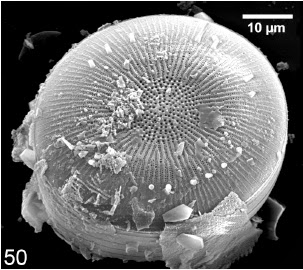Diatoms are single celled algae related to Kelp and Water Moulds. They are encased in silica shells with two valves. During reproduction the cells divide in two, each of which retains one valve of the shell, growing a new opposing valve, which is slightly smaller and fits flush within the older valve. This means that the Diatoms grow smaller with each new generation, until they reach a minimum size, when they undergo a phase of sexual reproduction, giving rise to a new generation of full-sized cells.
In a paper published in the journal Phytotaxa on 29 August 2013, Patrick Kociolek of the University of Colorado Museum of Natural History and the Department of Ecology and Evolutionary Biology at the University of Colorado and Galina Khursevich of the Department of Botany at the Maxim Tank Belarus State Pedagogical University, describe four new species of fossil freshwater Diatoms from Oregon and Idaho, all of which are placed in the genus Cyclotella.
The first new species described is Cyclotella idahica, which is described from specimens from Christmas Valley in Oregon and Payette County, Idaho. It is thought to be 11 to 12 million years old. Cyclotella idahica is an 8.0–48.0 μm oval or elliptical Diatom. It has an oval central zone, with an irregular arrangement of areolae (holes through which the organism obtained nutrients), surrounded by an outer rim in which pores are arranged in distinct bands.
Cyclotella idahica, Valve view showing transversely undulate central area with irregularly arranged areolae and covered by bumps. Present are external openings of areolae and short tubes of marginal fultoportulae. Spines and/or spines bases are found on the valve face/mantle junction. Scale bars is 1 μm. Kociolek & Khursevich (2013).
The second new species described is Cyclotella discostelliformica, which is described from material from two sites in Klamath County, Oregon. This is an almost circular diatom 5.0–17.0 μm in diameter. The center of the valve is concave with 5-17 areolae arranged apparently at random, this is surrounded by a number of bands of smaller pores arranged radially.
Cyclotella discostelliformica, External view showing valves with sunken central areas. Fascicles are composed of 2–5 rows of areolae. Openings of the marginal fultoportulae are located at or near the thickened ribs. They lack tubes or thickenings. The central portion of the valves have isolated areolae, that are larger than those of the fascicles. Scale bar is 1 μm. Kociolek & Khursevich (2013).
Third new species described is named Cyclotella stoermeri, which is named from a single site in Klamath County, Oregon. Cyclotella stoermeri is a 7–100 μm circular Diatom. It has a central area with areolae arranged in radial rows, surrounded by a ring of radial striations that brach dichotomously towards the rim.
Cyclotella stoermeri, external valve view. Fascicles are comprised of 1–3 rows of small areolae. The ribs are thickened and elevated, becoming thinner on the valve mantle. The valve center has enlarged areolae. Kociolek & Khursevich (2013).
The final new species described is named Cyclotella pseudokansasica, which is named from a single specimen from Owyhee County, Idaho. Cyclotella pseudokansasica is a 10–23 μm diameter circular Diatom with a central area with irregularly arranged areolae and a wider outer area with radiate bands of pores separated by distinct ribs.
Cyclotella pseudokansasica, external valve view. Prominent spines or spine bases are located about the periphery of the valves. Multiseriate fascicles alternate with thick costae. Openings of the marginal fultoportulae are located near the base of the mantle. Scale bar is 1 μm. Kociolek & Khursevich (2013).
See also The a Late Miocene-Pliocene Diatom redescribed from Scanning Electron Microscope images, New species of Diatom from Japan.
Follow Sciency Thoughts on Facebook.




